MESOSCALE TEMPERATURE FLUCTUATIONS:
AN OVERVIEW
Bruce L. Gary
Jet Propulsion Laboratory, Pasadena, CA
2000 January 10
Abstract
Synoptic scale assimilations of radiosonde and satellite data for the global temperature and wind fields are limited to spatial wavelengths longer than about 400 km. The assimilated wind field is frequently used to calculate back trajectories, and the temperature field is then used to caclulate histories of air parcel temperature. I call attention to two shortcomings in these calculations of air parcel temperature histories: 1) the absence of mesoscale features means that short timescale temperature fluctuations are omitted, and 2) the synoptic data are imperfect, leading to small errors in the synoptic component of temperature histories. The Microwave Temperature Profiler measures the temperature field within an altitude/ground track cross-section, and this provides an ideal means for evaluationg the magnitude of both error sources. This web page presents a preliminary evaluation of these errors.1. IntroductionIt is found that the first shortcoming of back trajectory temperatures, mesoscale temperature fluctuations, is greatest over land, especially mountainous topography, and is smallest over mid-latitude and high-latitude oceans. A seasonal effect is also present, with winter producing greater fluctuations. The spectrum of mesoscale fluctuations appears to be limited to periods of 12 hours and shorter, consistent with an atmospehric tides energy source. The amplitude of mesoscale fluctuations also appear to increase with altitude, possibly in the same manner as mountain waves. A stochastic algorithm has been derived for simulating mesoscale temperature fluctuations, that can be added to back trajectory temperature sequences for the purpose of evaluating the implications of the first shortcoming component. The second shortcoming of back trajectory temperatures, assimilation data base errors, can produce synoptic scale variations of several degrees K, and temperature offsets of as much as 3 K can persist for more than a day of parcel time. Additional cases must be studied before this component can be simulated using stochastic algorithms.
_____________________________________________
"I wouldn't have seen it if I hadn't believed it!"
(An old geologist saying.)
Observationalists are supposed to create new tools for viewing nature. When they create an instrument that opens a new "observational window," invariably new things are discovered that force theoreticians to revise, or at least refine, their models. The JPL Microwave Temperature Profiler is such an instrument. One of the most significant unexpected findings, though in retrospect it should have been anticipated, is the existence of an ever-present structure of mesoscale isentrope altitude displacements, implying the presence of corresponding temperature fluctuations. The 3-D temperature field has more structure than is represented by assimilated data fields. This is because the input to the assimilation model consists of smoothed radiosonde profiles and satellite measurements, which are inherently smoothed in both the horizontal and vertical directions. Even if satellite data contained structure in both directions, it would have to be smoothed to be consistent with the finite horizontal and vertical node spacing of the models. "Out of sight, out of mind." Some investigators have apparently been lulled into thinking that mesoscale temperature structure doesn't exist because it never shows up in assimilation temperature fields. Other investigators readily acknowledge that mesoscale fluctuations exist, but believe they are negligible for most model analyses.
In 1987 the JPL Microwave Temperature Profiler made measurements from a NASA ER-2 aircraft during the Airborne Antarctic Ozone Experiment. MTP data for the flight of 1987 September 22 was used to construct the first airborne "isentrope altitude cross-section," or IAC, from a single aircraft flight segment. By a happy coincidence this first IAC showed a mountain wave that was larger than any since observed (Gary, 1989). Gary (1989) and Bacmeister and Gary (1989) document with MTP data that the amplitude of short spatial wavelength variations of isentrope altitude is greater during flight over land than over ocean, at least at polar latitudes and during winter.
In 1989, during AASE II (Airborne Arctic Stratospheric Experiment II), the MTP aboard a NASA ER-2 aircraft continued to show mesoscale structure, but this time it got the attention of modelers trying to reconstruct parcel temperature histories along back trajectories. The existence of what experimenters in the field half-believingly referred to as "Gary's Fuzz" represented a potential concern to modelers who required accurate representations of parcel temperature histories being used to infer temperature-sensitive changes to aerosol chemistry and denitrification of the winter polar vortex. An isentrope surface from an MTP IAC had far more structure than was produced by back trajectory calculations. Studies began "in the field" to evaluate the implications of superimposing the MTP-required mesoscale temperature fluctuations onto back trajectory temperature histories (Wofsy et al, 1990). Murphy and Gary (1995) and Tabazedeh et al (1996) also explored implications of this new component of temperature structure.
The MTP is also an ideal instrument for evaluating the magnuitude of errors in an assimilated temperature field. This can be done by comparing MTP measured IACs with IACs prepared from synoptic temperature fields using "analyzed" data. It can also be done by low-pass filtering the MTP-generated IAC and comparing it with the assimilated field's IAC.
Modelers who are unsure of what errors to assign to the back trajectory temperature histories due to both assimilated field errors and mesoscale temperature fluctuations may find this web page to be a useful source of information. I suggest that every back trajectory requiring a careful analysis be subjected to a series of stochastic back trajectory calculations for the purpose of probing what temperature history the air parcel may in fact have experienced. I provide algorithms for deriving stochastic mesoscale and synoptic scale temperature history adjustments.
A companion web page, Mesoscale Fluctuation Amplitudes, describes a quantitative analysis of MFA for many regions, seasons, underlying topography and altitudes. Equations, and a table, summarize the dependence of MFA upon these four independent variables. The present web page is an introduction to the differences between the traditional synoptic scale isentrope altitudes and the same isentrope altitudes measured with mesoscale resolution by the airborne MTP instrument. Any user who is anxious for a quick start in performing a mesoscale fluctuation simulation is advised to jump to the above web page link and read the last section. This web page is meant for those wanting more background on the nature of mesoscale structure.
2. Mesoscale Versus Synoptic Scale Temperature Field Structures
Figure 1 is an example of a synoptic scale "altitude isentrope cross-section," or IAC, showing the altitude of potential temperature surfaces versus latitude along a ground track flown by NASA's ER-2 aircraft on March 27, 1994. It is based on assimilated data, relying upon radiosonde and satellite temperature measurements. It was produced by Schoeberl, Newman, Nagatani and, Lait of the NASA Goddard Space Flight Center (Code 916).
Figure 1. Isentrope altitude cross-section, based on assimilation data, for the ER-2 flight of 1994 March 27, from Fiji to New Zealand. The isentropes are 10 K of potential temperature apart, starting with 430 K (at about 17.3 km).
Figure 2. Measured isentrope altitude cross-section, using the 2-channel MTP/ER2 instrument.
Figure 2 is an IAC based on actual measurements by JPL's Microwave Temperature Profiler, or MTP, which is mounted in the ER-2 aircraft. All of the structure in this figure is statistically significant, as it is compatible with the in situ Meteorology Measurement System, or MMS. Indeed, the MMS requires that structure of this character be present. On many occasions I have found complete agreement between the IAC produced from only MTP data and an IAC produced by adopting the MTP-measured lapse rate (which usually varies slowly) and the MMS temperature data (which has many short-term fluctuations).
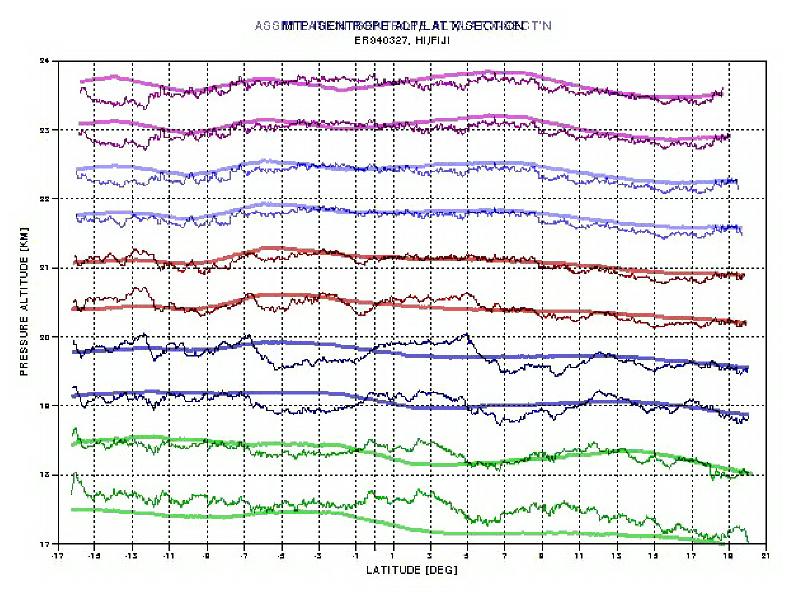
Figure 3. Overlay of Fig.'s 1 and 2, showing the the difference between mesoscale and synoptic scale sampling of the atmospheric temperature field.
Figure 3 compares the assimilated temperature field's IAC and the MTP-measured IAC. The differences reveal that a significant amount of mesoscale structure exists which is not captured by the synoptic scale assimilation. This comparison also shows the presence of small errors in the assimilated temperature field's IAC. Near flight level the RMS difference between the two isentrope altitudes is 170 meters, and the maximum difference is 390 meters. It is my subjective impression that the highest spatial frequencies in the synoptic plots are misleading, which is to say that about half the time the small structures in the synoptic isentropes do NOT correlate with features in the measured isentropes.
Lest the reader suspect that these discrepancies only exist at tropical
latitudes, or that they are only found when using the 2-channel ER-2 MTP,
the following example covers a latitude region from Hawaii to Alaska, and
a 3-channel MTP mounted on the DC-8 aircraft was used during the TOTE/VOTE
flights of 1995/96.
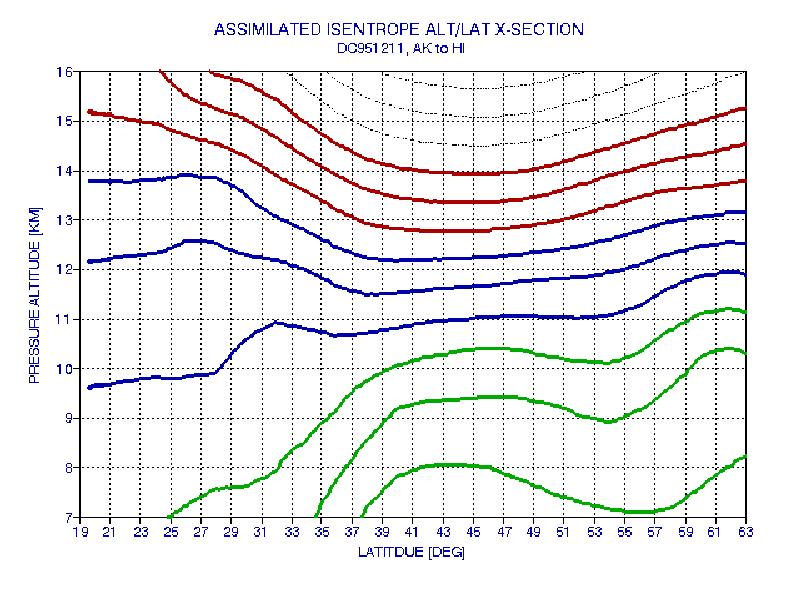
Figure 4. Isentrope altitude cross-section, based on assimilation data, for the DC-8 flight of 1995 December 11, from Alaska to Hawaii. The isentropes are 10 K of potential temperature apart, starting with 310 K (at 8 km, latitude 43 North).
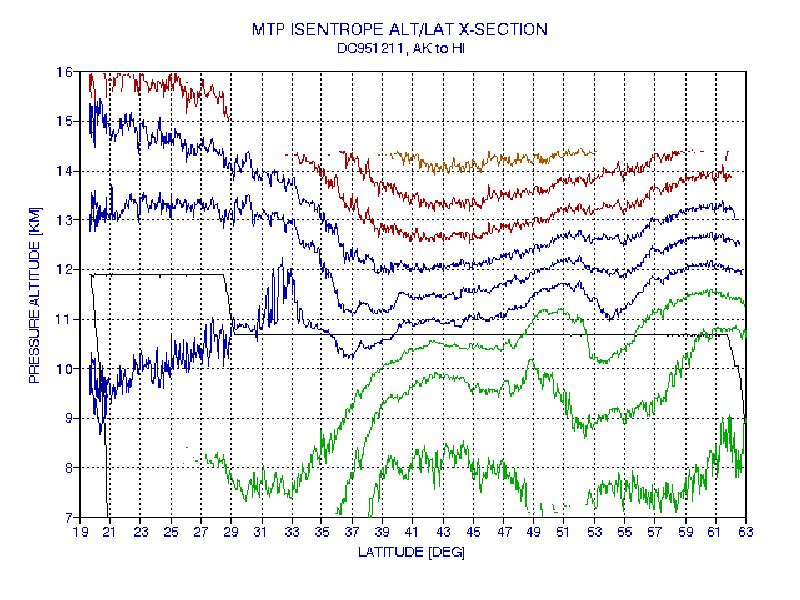
Figure 5. Measured isentrope altitude cross-section, using the 3-channel MTP/DC8 instrument.
This isentrope altitude cross-section shows much more structure than the assimilated version. In particular, a sub-polar jet has distorted the isentrope field at about 53 degrees North latitude, 10.5 km. Also, the sub-tropical jet has produced steeper isentrope surfaces at 35 North latitude and 10 to 12 km.
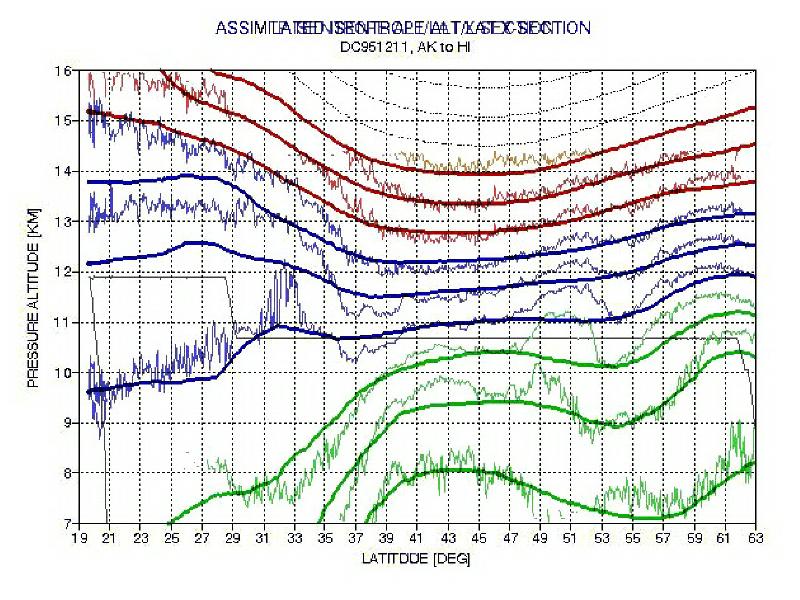
Figure 6. Overlay of Fig.'s 4 and 5, showing the the difference between mesoscale and synoptic scale sampling of the atmospheric temperature field on the Alaska to Hawaii flight.
Figure 6 shows that not only are isnetrope shapes much more interesting in the real world, but assimilated isentrope altitudes can be in error by as much as 900 meters, such as at 51 degrees North latitude, at 10 to 11 km, and also at 21 degrees latitude, 12 to 16 km. The effect of the sub-tropical jet, located at 35 degrees North and 10.4 km, is dramatic in the MTP data, but very subdued in the assimilation data. In case the reader wonders if the isentropes really are as dramatically sloped as the MTP measurements suggest, the following figure is presented.
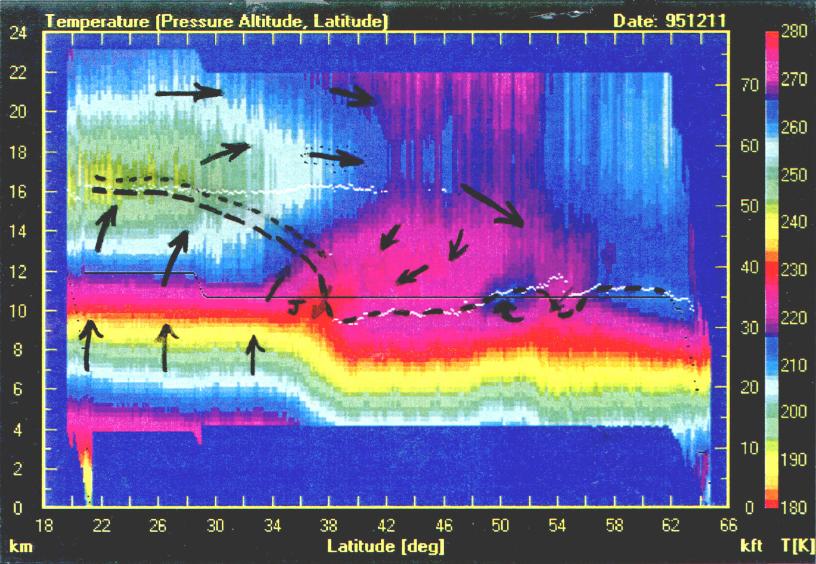
Figure 7. Color-coded air temperature derived from the MTP/DC8 instrument during the 1995 December 11 DC-8 flgiht from Alaska to Hawaii.
The heavy dashed line is the "tracer tropopause" and is based on ozone and other tracers. In the vicinity of the sub-polar jet in situ tracer measurements were used to define the tracer tropopause, and there is corroboration that the temperature field is distorted at the same location as the tracer field. In the vicinity of the sub-tropical jet both in situ and remote tracers are used to define the tracer tropopause. The Langley DIAL ozone profiler provided isopleths of ozone mixing ratio, which defines the tracer tropopause above the aircraft south of 36 degrees North latitude. By combining in situ and remote tracers it was possible to derive a very steep slope for the tracer tropopause at 38 degrees North latitude, just poleward of the jet. All these tracer tropopause behaviors are consistent with the expected circulation of air in the vicinity of jets. A more complete description of this flight is given at DoubleTropopause. The purpose in presenting this figure is to support the MTP version of the isentrope field as providing accurate mesoscale temperature field structure that is missing in assimilated temperature fields.
3. Mesoscale Temperature Fluctuations
Figure 8. Altitude of one isentrope measured by the MTP/ER2 on a cross-country flight. The thin red trace is measured, unfiltered, and the thick black trace is filtered to simulate synoptic resolution.
Figure 8 is another example of isentrope structure at ER-2 altitudes, again at mid-latitudes. In this figure only one isentrope's altitude is shown. Since vertical displacements correspond to adiabatic temperature changes, this data shows that reliance upon assimilated (synoptic) temperature field data for deriving time histories of temperature for an air parcel will underestimate the extent of actual temperature variations. Note that since the measured temperature field was smoothed to remove remove the synoptic component of variations, this temperature difference trace does not include errors that would be present if a "true" verus "assimilated" back trajectory temperature trace were being differenced. The following temperature difference trace is therefore an underestimate of differences between "true" and "assimilation field calculated" for a back trajectory temperature calculation.
.png)
Figure 9. Temperature difference, mesoscale measured minus synoptic scale, versus parcel time for the 1991.11.02 flight.
The 1991.11.02 flight encountered a constant wind of 24 [m/s] moving generally eastward, parallel to the direction of flight. Since an air parcel will follow an isentrope surface (provided diabatic heat exchanges are small) we are able to use the 490 K isentrope to infer an air parcel's temperature versus time. Figure 9 shows how an air parcel, traveling along the 490 K isentrope, would change temperature if the 490 K isentrope surface did not change shape during the parcel's 2-day trip. It doesn't matter that we don't know how the isentrope surface changed during any 2-day period of a hypothetical parcel trajectory, since we are only interested in a qualitative assessment of the importance of neglecting mesoscale structures when calculating parcel temperature histories. Figure 9 provides a qualitative answer, for one real atmosphere setting chosen at random.
Figure 10. Histogram of temperature differences in Fig. 9.
Figure 10 shows that the mesoscale versus synoptic scale temperature differences can be fitted by a Gaussian, and the Gaussian's "full-width at half-maximum" equals 1.6 K. I shall refer to the "full-width at half-maximum" parameter as the "mesoscale fluctuation amplitude," or MFA. Thus, MFA = "half-power width" of the mesoscale-only temperature fluctuation histogram. It can be quickly estimated from a data sample by drawing a smooth line through a measured isentrope surface altitude (leaving out all spatial components with wavelengths shorter than about 400 km), then counting or estimating a "probable error difference" (such that 50% of actual data exceed this probable difference), then multiplying by 3.33 to arrive at the "full-width half-maximum" estimate, and finally dividing by 100 meters/K (since every 100 meter altitude displacement corresponds to about 1.0 K of temperature change, when variations are fast and clouds are not present). MFA can also be estimated from the fact that 76% of all cases will be contained within the upper and lower MFA boundaries. Finally, MFA can also be computed by multiplying an RMS difference by 2.27 (an RMS can be estimated from the fact that in a normal distribution 68% of deviations will have an absolute value less than the RMS; the factor 2.27 has been empirically determined for MTP data, and is close to the value 2.36 that corresponds to a perfect Gaussian distribution). Section 5 includes a table of MFA values for a variety of location and season settings.
4. Assimilated versus Measured Temperature Fluctuations
Refer back to Fig. 8, which shows the effect of filtering a measured isentrope surface altitude versus distance (from which temperature histories can be derived). In the next figure we shall see the solution for the same isentrope surface derived from a assimilated data base (as archived in the XS-file for AASE2).
Figure 11. The blue trace is the altitude of the 490 K isentrope surface for the assimilated temperature field (from an XS-file) for flight ER911102; the other traces are the same as in Fig. 8.
First, note the offset of the 490 K isentrope derived from the assimilated data base. It ranges from about 0.2 km to 0.4 km (i.e., 2.0 K to 4.0 K). Also note the lack of spatial structure corresponding to wavelengths between 600 km and about 2000 km. We are now able to perform a calculation of "true" versus "assimilated" parcel temperature versus parcel time, a counterpart to Figure 9, and this is shown in the next figure.
.jpg)
Figure 12. Measured parcel temperature versus assimilated field parcel temperature for the 490 K isentrope surface, for the flight of ER911102. This is essentially an estimate of the error of a 2-day back trajectory parcel temperature versus time. Longer back trajectories would likely exhibit greater maximum errors.
The two shortcomings of using an assimilated field for calculating parcel temperature is apparent in Fig. 12: the assimilated field's 1) offset, and 2) lack of short wavelength spatial components for an isentrope's altitude. These shortcomings create noticeably larger variations for the trace of "parcel temperature error using back trajectories" in addition to a 2 or 3 K offset.

Figure 13. Histogram of temperature differences in Fig. 12.
For the case of ER911102, chosen at random, the histogram of "back trajectory air parcel temperature" differences from that inferred from MTP-measurements is much larger than the histogram of Fig. 10, and it has an offset with respect to zero. The best way to "understand" this histogram is to remember that it consists of two components: 1) a quasi-stochastic component, with a quasi-Gaussian spread, and 2) an offset component, which will vary gradually with location (i.e., parcel time). The stochastic component is associated with "mesoscale temperature fluctuations," and has a characteristic "width" that will depend on location on the earth, and season. The offset component is associated with asimilation errors, and will slowly vary, wandering on both sides of zero. The offset component will be larger over the ocean, or wherever radiosondes are sparse (and only saellite or ship soundings are available). Figrues 1 to 3 suggest that this component may be larger in the tropics, where assimilation models have trouble constraining solutions.
In describing Fig. 10 I used the term MFA to represent the Gaussian's "full-width at half-maximum." Whereas Fig. 10 had an MFA = 1.6 K, Fig. 13 has MFA = 2.4 K. Figure 10 requires one more parameter to describe it, the offset, which is 3.2 K. (The procedure for deriving Fig. 10 assured that it would have no offset.) Since we know the contribution of mesoscale fluctuation variations to the observed spread in Fig. 13 (1.6 K), we are able to determine the contribution to Fig. 13's spread due to "assimilation error wander." The orthogonal subtraction of 1.6 K from 2.4 K gives 1.8 K, and this must be the wander variation of assimilation error for the 2-day parcel trajectory of ER911102. Thus, we have just characterized the contribution of shortcomings of the assimilated data base to the back trajectory temperature history that would be calculated for an air parcel found above Maine, at the 490 K surface, on 1991 November 2 just before the ER-2 descended to land. It will be useful to name the two parameters that characterize this variation, which I have done in the following list, which also summarizes their evaluations based the ER911102 case:
Parameters Describing Assimilation Temperature Field Errors in Back Trajectory Calculations
Trajectory Temperature Error Offset 3.2 K for ER911102, 2-day trajectory
Trajectory Temperature Error Variation 1.8 K for ER911102, 2-day trajectory
The procedure for deriving the above trajectory errors is an underestimate because it does not include errors due to a faulty wind field; it only reflects errors in the assimlated temperature field. More analysis will be required to assess this additional component of trajectory temperature history errors. (I'm open to a collaboration with someone on this.)
When more cases have been analyzed, it will be useful to represent the trajectory temperature history error characteristics by deriving an algorithm that creates simulated trajectory temperature histories based on the above two parameters, the "Trajectory Error Offset" and "Trajectory Error Variation." The goal would be to provide a method of creating simulated trajectory temperature histories using a stochastic procedure similar to the one I describe in Section 6, below, for representing simulated mesoscale temperature fluctuations. When this has been achieved it will then be possible to calculate a series of simulated dT(t) series for addition to a back trajectory T(t), which would then be used for evaluation by models that calculate other things, such as the likelihood of cloud formation, or the amount of a chemical reaction that is very temperature dependent, etc. The next figure may be helpful in visualizing the distinction between "trajectory temperature variations" and the faster "mesoscale temperature fluctuations," both of which must be combined for deriving dT(t) series to be used in simulating the effects of temperature variations not captured by the back trajectory temperature result:
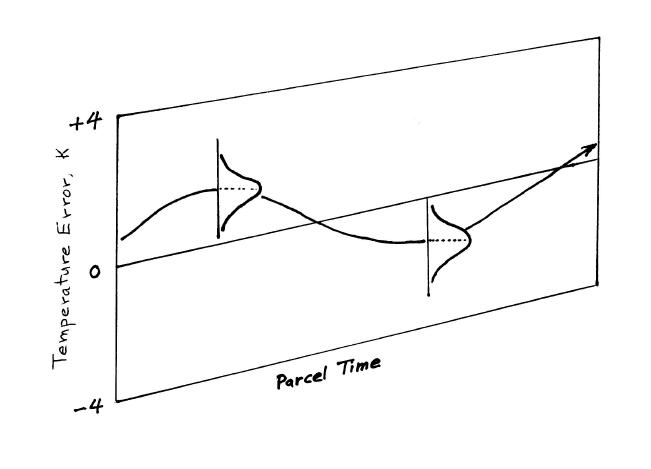
Figure 14. Sketch showing an example plot of "back trajectory temperature error" in relation to histograms for the faster "mesoscale temperature fluctuations."
In this figure I represent the slowly varying componnet of error in back trajectory temperature history due to assimilation data base errors using a smooth trace, whereas the faster mesoscale temperature fluctuations are represented by histograms. The two components must be added in deriving a simulation of a temperature history error trace that should be added to a caclulated back trajectory temperature trace. Since both components are usually not known, due to limitations of the assimilation data dase from which the back trajectory is calculated, they must be constructed using stochastic algorithms, and many such constructed dT(t) series must be added to the one calculated back trajectory T(t) to evaluate the magnitude of effects that can be attributed to the unknown temperature variations.
A goal for future work is to fabricate stochastic algorithms that adequately represent these unknown temperature variations. Section 6, below, describes an algorithm for constructing realistic mesoscale temperature fluctuations. So far, my analysis of comparisons of MTP-derived isentropes with assimilated isentropes is insufficient to permit the derivation of stochastic algorithms to represnet this component of variation.
5. Spectral Properties of Mesoscale Temperature Fluctuations
In order to understand the origin of the mesoscale isentrope wrinkles, which produce temperature fluctuations for constant altitude flight, it will be useful to investigate their sepctrae. This section is devoted to only ER-2 flights that were mostly parallel to the wind, which means the isentropes can be treated as "streamlines" for air flow, and the altitude excursions of the streamlines can be converted to temperature excusrions under the adiabatic motion assumption.
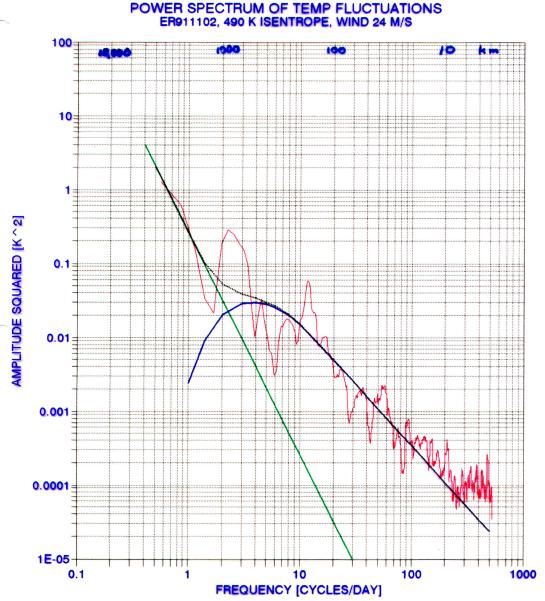
Figure 15. Power spectrum of temperature fluctuations for flight ER911102, based on MTP isentrope altitudes.
A specific isentrope altitude was used to produce the above figure. Since the wind speed was an almost constant 24 m/s during the flight, a conversion was possible from ground track distance to parcel time, allowing for the spectrum to be presented in terms of "cycles per day." A few spatial wavelengths have been noted at the top of the graph. The well-known synoptic spectral index of -3 has been fitted to the long spatial wavelength data. A mesoscale component having a high spatial frequency spectral index of -5/3 has been fitted to the data. This component has a rounded low spatial frequency "termination" that was arbitrarily chosen to provide a good fit of the sum of the two components to the measurements for this and other flights. The measured spectrum at high spatial frequencies appears to "level off" at about 0.0001 [K^2]. Since the MTP instrument looks forward some kilometers, this type of high frequency feature is expected. In the next figure it will be shown that there is no leveling off of the real spectrum.
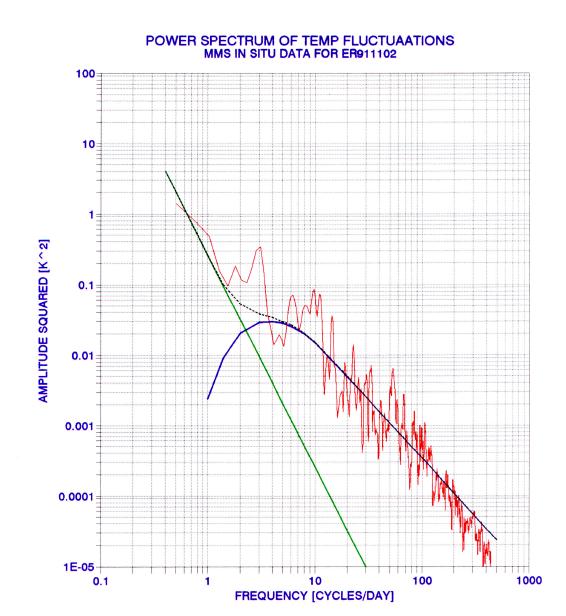
Figure 16. Power spectrum of temperature fluctuations for flight ER911102, based on MMS in situ temperature measurements and MTP-based lapse rate.
This figure represents the spectrum of temperature fluctuations that would be expected from in situ MMS (Meteorology Measurement System, an Ames Research Center instrument) measurments of air temperature, which are taken at 5 Hz and averaged to 1 Hz for sharing with other experimenters. The in situ measurements do not contain the MTP-type averaging along the flight path, so their high spatial frequency shape can be trusted. To produce such a plot it was necessary to use MTP-derived lapse rates, and to assume that lapse rate for the 1-km thick layer of MTP measurements could be applied throughout the altitude region between the aircraft and the 490 K isentrope (this assumption is minor, and even an isothermal assumption would produce essentially the same result for this altitude regime). Notice that the measured spectrum of parcel temperature fluctuations continues to decrease in approximate agreement with the -5/3 slope of the fitted line.
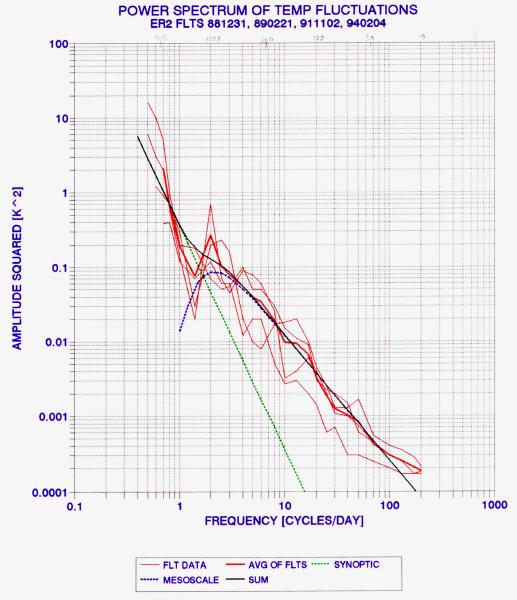
Figure 17. Parcel temperature fluctuation spectrae of 4 ER-2 flights meeting the wind direction criterion.
Only four ER-2 flights have been analyzed to produce parcel temperature fluctuation spectrae. Most ER-2 flights are not satisfactory for this analysis, often because the wind direction is not parallel to the flight direction, but also because there are "altitude dips" in the middle, or the flight does not cover a large distance because the landing and take-off site are the same. All the data in Figure 4 are from MTP isentrope altitude data. Notice that they all have the same spectral index for the mesoscale part of the sepctrum, i.e., for frequencies higher than about 2 cycles/day - corresponding to a wavelength of approximately 1000 km (for the wind speeds encountered). Note also that the spectral density level (Fourrier amplitude squared) can vary by almost a factor of 10 from flight to flight (and probably more, if more than 4 flights could have been analyzed). Another intriguing aspect of these spectrae is that all flights show a "dip" in the spectrum at 1.5 cycles/day, and a maximum at 2 cycles/day. If atmospheric tides were the source for these fluctuations then I think 2 cycle/day would be their "source frequency."

Figure 18. Four-flight average spectrum of MTP/ER2-determined parcel temperature fluctuations (red) in relation to fits of synoptic scale and mesoscale components. The dotted line is from Nastrom and Gage's 1985 study of commercial altitude temperature fluctuations.
Figure 18 summarizes the MTP/ER2 analyses of parcel temperature fluctuations, showing an excellent fit at mesoscale frequencies to a -5/3 spectral index component that has been shifted vertically to achieve a good fit. The high measurements at the highest frequencies is due to the MTP limitation in which measurements include averaging along the flight path, so can be disregarded. The best fit slope for the 3 to 100 cycels/day region is -1.70 +/- 0.04, which is statistically compatible with -5/3 (i.e., -1.67). Nastrom and Gage (1985) published a classic analysis of temperature fluctuations from commercial aircraft showing the transition from a slope of -3 at synoptic scales to -5/3 at mesoscales, where their transition region was at about 2 or 3 cycles/day.
It was not apparent to me how to convert their spectral density scale to the one I use, so I took the liberty of vertically shifting their curve so that it agreed with my synoptic scale (green dashed line) fit. Thus, the lower position of their mesoscale component, in relation to mine, is subject to the correctness of this adjustment. I have taken the position for eyars that the isentropes are more wrinkled at ER-2 altitudes than at DC-8 altitudes, and have assumed that this greater amplitude at the higher altitude can be attributed to the same physical process that causes mountain waves to exhibit an amplitude growth with altitude. I show in Gary (1989) that mountain wave amplitude increases with altitude as the reciprocal of the square-root of air density, which accords with the theory that wave motion energy is conserved with altitude. If the typical altitude of the aircraft in the Nastrom and Gage study is taken to be 11.0 km (36,000 feet), and adopting a typical ER-2 altitude of 19.8 km, the "reciprocal of the square-root of air density" relation predicts that at ER-2 altidudes the mesoscale altitude excursions should be 2.0 times greater than the Nastrom and Gage excursions. In other words, the spectral energy, which is proportional to the square of the amplitude, is predicted to be 4 times greater at ER-2 altitudes compared with commercial flight altitudes. In Figure 17 the two amplitudes appear to be have a ratio of 5 or 6, which is slightly higher. It may be significant that Nastrom and Gage find slightly higher amplitudes above the tropopause than immediately below. I haven't researched the quantitative relation for this tropopause crossing change, so I cannot now be quantitative about it. For now, it is quite likely that the "wave motion energy conserving theory" for vertical displacements of isentropes versus altitude can account for the amplitudes measured by both Nastrom and Gage and the MTP aboard the ER-2, reported here.
6. Algorithm for Simulating Mesoscale Temperature Fluctuations at ER-2 Altitudes
The present section presents an algorithm for creating synthetic sequences of temperature deviation (from a synotic temperature sequence). The algorithm was derived empirically so that the resultant temperature fluctation sequences exhibit the same shape for power spectrae described in the previous section. For the user who will be satisfied with portions of a sample mesoscale temperature fluctuation sequence, I recommend the far simpler method of skipping this section and going straight to the Mesoscale Fluctuation Amplitude link, and reading the last section.
The following is an analytic expression, so it is suitable for uses requiring a large amount of computer-generated dT(t). This algorithm produces spectrae that "look like" real, measured spectrae from the MTP/ER2. The equations incorporate an empirically-derived randomizing feature for producing Gaussian noise in specifiying the sine and cosine amplitudes. The effect of this random Gaussian noise is to produce more negative noise than positive, and both negative and positive noise increases with spatial frequency (when noise perturbations are expressed as ratios). These are apparently essential features for the proper synthesis of dT(t) traces. The sine and cosine components for spatial frequency f, Asin(f) and Acos(f), are calculated from the following algorithm:
The sine and cosine components for spatial frequency f, Asin(f) and Acos(f), are calculated from an equation for their square:Asin2(f) = R * f (-5/3)
where R = 10mX ... note, R ~ 1.0 since X ~ 0; R will range from slightly above 0.0 to maybe 2 or 3.
X = -0.46 * Loge(1/RND - 1) ... this is a quick Gaussian function, returning + & - values with normal distribution having RMS = 1,
m = 0.3 + 0.1 Log10 (f) when X > 0,
m = 1.2 + 0.5 Log10 (f) when X < 0.Spatial frequencies form a uniform sequence, f = 0.2775 [cycles/day] * N, where N = 1, 2, 3, ... 746 (i.e., fmax = 207.015 [cycles/day]).
To see the QuickBASIC program that creates Fourier components and then uses them to construct a dT(t) trace, click on MESOSCALE_SIMULATION.
This is the correct way to represent a data sequence that is 1.8 days long represented by 745 values. The data sequence actually consists of 2070 values, permitting components up to a maximum of 575 cycles/day to be included; however, excluding them is equivalent to low-pass filtering with a cut-off corresponding to the limit available for a data set with 4.9 minute sampling. Inspecting the data indeed shows that the shortest spatial frequency is approximately the 7.0 minutes of parcel time that is expected from the use of a maximum spatial frequency of 207 cycles/day. For an aircraft travelling at Mach 0.75, or 218 meters/second, the maximum spectral component of fluctuation represented by the synthesized data is 46 seconds. The present analysis is therefore compatible with the goal of assessing the frequency of streamline slopes for distance spans of approximately 50 meters (or 14 seconds of aircraft travel time). The set of Asin(f) and Acos(f), after performing the "noisy" adjustments, are used to straight-forwardly calculate a dT(t) trace, an example of which is shown in the next figure.

Figure 19. Synthetic and actual time histories of parcel temperature, showing the subjectively correct appearance of the synthetic trace. Both traces are to be added to slowly-varying synoptic scale fluctuations.
I present this algorithm with the hope that modelers will use it to calculate "mesoscale add ons" for converting assimilated parcel trajectory temperature histories to produce statistically more representative parcel trajectory temperature histories.
7. MFA Statistics
A complete description of the dependence of mesoscale fluctuation amplitude, MFA, upon the four independent variables season, latitude, underlying topography and altitude is presented in another web page, Mesoscale Fluctuation Amplitudes.
There are many clues concerning the origin of the mesoscale temperature
fluctuations. A brief discussion of these clues is given int he above
web page.
REFERENCES
Bacmeister, J. T. and B. L. Gary, 1990, Small-Scale Waves Encountered During AASE," Geophys. Res. Lett., 17, 349-352.
Gary, B. L. 1989, "Observational Results Using the Microwave Temperature ProfilerDuring the Airborne Antarctic Ozone Experiment," J. Geophys. Res., 94, 11223-11231.
Murphy, D. M. and B. L. Gary, 1995, "Mesoscale Temperature Fluctuations and Polar Stratospehric Clouds," J. Atmos. Sciences, 52, 1753-1760.
Nastrom, G. D. and K. S. Gage, 1985, "A Climatology of Atmospheric Wave Number Spectra Observed by Commercial Aircraft," J. Atmos. Sci., 42, 950-960.
Tabazadeh, A., O. B. Toon, B. L. Gary, J. T. Bacmeister and M. R. Schoberl, 1996, "Observational Constraints on the Formation of Type Ia Polar Stratospheric Clouds," Geophys. Res. Lett., 23, 2109-2112.
Wofsy, S. C., G. P. Gobbi, R. Salawich and M. B. McElroy, 1993, "Vapor Pressure of Solid Hydrates of Nitric Acid: Implications for Polar Stratospheric Clouds," Science, 259, 71-74.
Wu, D. L. and J. W. Waters, 1996, "Gravity-Wave-Scale Temperature Fluctuations Seen by the UARS MLS," Geophys. Res. Lett., 23, 3289-3292.
Wu, D. L. and J. W. Waters, 1996, "Satellite Observations of Atmospheric Variances: A Possible Indiocation of Gravity Waves," Geophys. Res. Lett., 23, 3631-3634.
Related Links
Mesoscale Fluctuation Amplitude Model Statistical analysis of ER-2 and DC-8 flight data
Calculating "Colder Than Synoptic" Statistics Example of Calculating "Mesoscale Fluctuation Amplitude" (MFA) as well as "colder than synoptic" statistics
Clear Air Turbulence Overview of my views on CAT generation
Main Menu Meteorology and clear air turbulence web pages
____________________________________________________________________
This site opened: June 3, 1999. Last Update: February 27, 2002